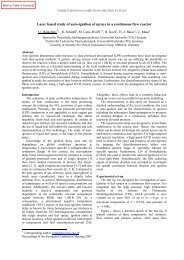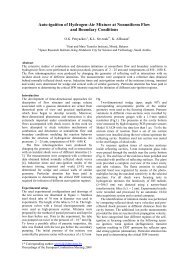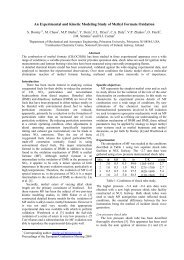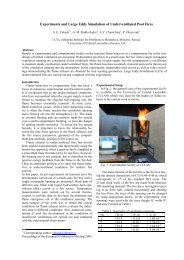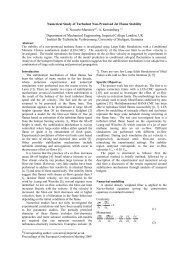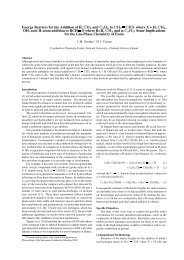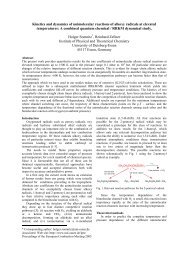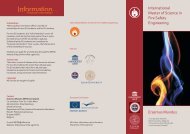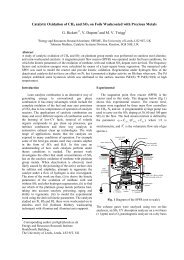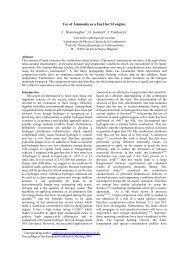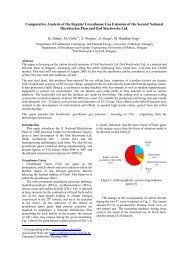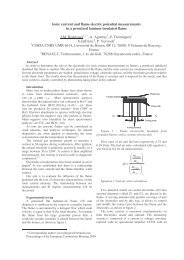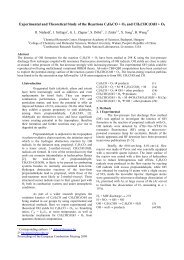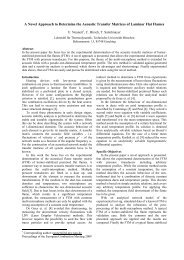Autoignition Temperatures for Mixtures of Flammable Liquids with ...
Autoignition Temperatures for Mixtures of Flammable Liquids with ...
Autoignition Temperatures for Mixtures of Flammable Liquids with ...
You also want an ePaper? Increase the reach of your titles
YUMPU automatically turns print PDFs into web optimized ePapers that Google loves.
fuel concentration in % by vol.<br />
Fig. 4:.Relation between the UEL at 1 bar and 10 bar, maximum<br />
possible concentration and the range <strong>of</strong> autoignition <strong>for</strong> n-propanol<br />
fuel concentration in % by volume<br />
50<br />
40<br />
30<br />
20<br />
10<br />
0<br />
50<br />
40<br />
30<br />
20<br />
10<br />
0<br />
max. concentration at 1 bar<br />
max. concentration at 10bar<br />
UEL at 10 bar<br />
Upper explosion limit at 1 bar<br />
LEL at 1 and 10 bar<br />
autoignition temp. at 10 bar<br />
Explosion range at 1 bar<br />
0 50 100 150 200 250<br />
LEL at 1 bar and 10 bar<br />
max. concentration at 1 bar<br />
max.concentration at 10 bar<br />
UEL at 1 bar<br />
UEL at 10 bar<br />
AIT at 10 bar<br />
Fig. 5: Relation between the UEL at 1 bar and 10 bar, maximum<br />
possible concentration and the range <strong>of</strong> autoignition <strong>for</strong> n-hexane<br />
Ignition delay times<br />
Due to limited reaction rates, some time will pass<br />
between the admission <strong>of</strong> the fuel and the actual occur<br />
rence <strong>of</strong> the explosion. For determination <strong>of</strong> the AIT it<br />
is there<strong>for</strong>e necessary to wait <strong>for</strong> some time be<strong>for</strong>e the<br />
outcome <strong>of</strong> a run can be regarded as "no ignition".<br />
Under atmospheric conditions the standards require<br />
a waiting time <strong>of</strong> 5 min which is usually sufficient to<br />
avoid the possibility <strong>of</strong> overlooking an explosion due to<br />
a very high ignition delay time. As ignition delay times<br />
are closely related to reaction rates, they can, however,<br />
be shown to follow an Arrhenius-like relation /4/:<br />
~ τ<br />
T / ° C<br />
Explosion range at 1 bar<br />
⎛ ZV<br />
k<br />
⎞<br />
⎜<br />
E A<br />
⋅ ⎟<br />
n<br />
p ⎜ ⎟<br />
⎝ RT ⎠<br />
exp<br />
Range <strong>of</strong> autoignition<br />
at 10 bar<br />
Range <strong>of</strong> autoignition<br />
at 10 bar<br />
0 50 100<br />
T / ° C<br />
150 200<br />
where EA ZV is an apparent activation energy. There<strong>for</strong>e<br />
it is expected that due to the lower ignition temperatures<br />
remarkably longer ignition delay times can be observed<br />
at higher pressures. An extreme example is displayed in<br />
Fig. 6 where it takes more than 35 min (2100 s) <strong>for</strong> a<br />
50%-benzene/50%-hexane mixture to ignite at a<br />
pressure <strong>of</strong> 13.5 bar and 197°C.<br />
As can be also seen from Fig. 6, the ignition delay is<br />
not only influenced by chemical factors (reaction rates),<br />
but also by physical factors like vaporisation and<br />
Explosion range at 10 bar<br />
Explosion range at 10 bar<br />
diffusion rates or the time to heat up the cold injected<br />
liquid. As most <strong>of</strong> these factors have an Arrhenius-like<br />
dependency on temperature similar to the reaction rate,<br />
it is nevertheless possible to obtain a straight line in an<br />
Arrhenius plot. This is demonstrated <strong>for</strong> four compounds<br />
in Fig. 7. The data taken <strong>for</strong> pressures from<br />
2 bar to 15 bar all fall on a single line if a first order<br />
dependence on pressure is assumed. In contrast, delay<br />
times observed at 1 bar <strong>with</strong> the standard apparatus do<br />
not fit on the line but are consistently longer than<br />
expected from an extrapolation from the high pressure<br />
values. They are there<strong>for</strong>e excluded from Fig. 7.<br />
Temperature in ° C<br />
t ZV *p Z in bar*sec<br />
3<br />
300<br />
280<br />
260<br />
240<br />
220<br />
200<br />
180<br />
8<br />
0 500 1000 1500 2000 2500<br />
Time (from start <strong>of</strong> injection) in s<br />
Fig. 6:<strong>Autoignition</strong> <strong>of</strong> a benzene/hexane mixture at<br />
197°C: Igniton delay time > 35 min<br />
10000<br />
1000<br />
100<br />
10<br />
pressure<br />
temperature at the centre <strong>of</strong> autoclave<br />
temperature at the top <strong>of</strong> autoclave<br />
benzene<br />
butyl amine<br />
cyclohexanone<br />
propionic acid<br />
200 250 300 350 400 450 500 550<br />
Temperature in ° C<br />
Fig. 7: Representative Arrhenius plots <strong>for</strong> ignition delay times <strong>with</strong> a<br />
first order dependency on pressure<br />
Apparent activation energies can be calculated from<br />
the slopes <strong>of</strong> the lines in Fig. 7. They may be used to<br />
estimate the delay times <strong>for</strong> reactions at different pressures.<br />
As they are composed <strong>of</strong> several factors, they are,<br />
however, not expected to agree well <strong>with</strong> activation<br />
energies calculated or measured by different methods.<br />
<strong>Autoignition</strong> temperatures<br />
The primary objective <strong>of</strong> the present work is to<br />
determine the autoignition temperatures at elevated<br />
pressures. The results obtained so far <strong>for</strong> pure compounds<br />
are summarised in Tab. 2 and compared to the<br />
values measured at atmospheric pressure <strong>with</strong> a standard<br />
DIN or ASTM apparatus. They include a number<br />
<strong>of</strong> different groups <strong>of</strong> organic compounds such as<br />
16<br />
15<br />
14<br />
13<br />
12<br />
11<br />
10<br />
9<br />
Pressure in bar



